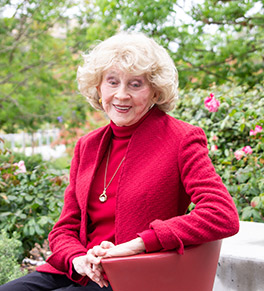High-touch support for low-vision patients

When macular degeneration, retinitis pigmentosa, glaucoma and other eye diseases impair vision so much that it affects daily life, people often feel a sense of loss and despair.
But there is help, say the low-vision specialists at the UCI Health Gavin Herbert Eye Institute.
Advancements in optical tools and new technologies like telescopic devices that attach to glasses now allow many people with low vision to navigate daily life and get back to doing what they love — whether it be reading or golfing.
The eye institute’s unique Low Vision Rehabilitation Program is led by UCI Health optometrist Karen Lin, OD, and occupational therapist Nilima Tanna, who brings the program into patients’ homes.
“Everyone has different visual acuities and a different sweet spot in their vision they can use, even with macular degeneration or retinopathy,” says Tanna.
“Our goal is to help them maintain or achieve independence and to be able to participate in meaningful activities. We focus on maximizing a person’s ability to use their remaining vision, to empower them with education about contrast and lighting, and teach them compensatory strategies. It’s not a cookie-cutter approach.”
Finding the sweet spot
While ophthalmologists manage eye health and treat the causes of low vision, it’s the optometrist’s role to explore the extent of a patient’s existing vision, Lin says. “One person may have good peripheral vision even if central vision is lost. Another may struggle with reading only when the contrast is low.”
During an initial consultation, Lin reviews information from the patient’s referring ophthalmologist then performs a comprehensive eye examination to determine the patient’s visual strengths and weaknesses. This includes a contrast test to assess their ability to distinguish shades of gray and a central visual field test to check for blind spots. Next comes a trial framing to place powerful lenses into a pair of wearable glasses.
Lin also offers patients a mix of additional high- and low-tech solutions ranging from simple magnifiers to desktop reading devices. The results can be profound.
Recently, a caregiver brought in a patient who was so uncommunicative they weren’t sure if he could read English. When Lin put a pair of high-powered reading glasses on the man, he perked up, began talking and reading aloud. Another patient cried tears of joy while looking at a photo of her grandchild through a magnifying device and exclaimed, “Oh, that’s what he looks like now!”
Bringing it home
Trying out these optical tools in a doctor’s office and using them in daily life are two entirely different experiences. A distinctive aspect of the eye institute’s low-vision service is that Tanna teaches patients how to use these tools and strategies in their own homes.
“I really want to know what their day-to-day life is like, so that I can understand who they are and what their needs are,” says Tanna, who has worked with low-vision patients for more than 20 years.
In a typical home session, she observes how the patient functions in their home and assesses what they need and want to accomplish in their daily lives. Do they want to be able to “spot read” labels and bills, or peruse books and magazines?
“It’s about getting to know each person, their social support network and how they’re coping with their impairment psychologically,” she says. “If they also have cognitive issues, how do we adjust to make things simple enough for them to participate in a rehabilitation process?”
Many of Tanna’s patients are working professionals or serve on boards and need to be able to read reports and make presentations. Others are retired but rely on their vision to stay active.
Navigating a new normal
When Fran Newman was diagnosed with age-related macular degeneration (AMD), rendering her legally blind in one eye, she feared she would no longer be able to volunteer with local charities or enjoy daily runs on the beach. More important, her lifetime habit of voracious reading and writing was suddenly at risk.
Tanna made three visits to Newman’s Newport Beach home to make her environment easier to navigate. She marked frequently used buttons on the microwave and stove with bright orange paint that expands and puffs up as it dries.
She arranged Newman’s computer to give her easy access to audio books, showed her how to use her iPhone’s magnification app and recommended using different light bulbs for various tasks. She also showed Newman how wearing a sun visor indoors could reduce bothersome glare.
The retired vice president of Cerritos College says her favorite tool by far is a digital reading machine that enlarges any text. She uses it daily to read books about leadership and write summaries about them for busy executives.
“It’s so easy to want to give up when you have age-related macular degeneration because there’s no cure for it,” says Newman, now 88. “But Nilima and the eye institute team have given me such useful and practical ways to help me cope with daily living.”
Lin developed her passion for helping people with impaired vision as a National Eye Institute research intern at UC Berkeley nearly 20 years ago when there were few resources to offer.
“Now when I see patients struggling,” she says, “I tell them there are always things we can do to help you still enjoy life.”




